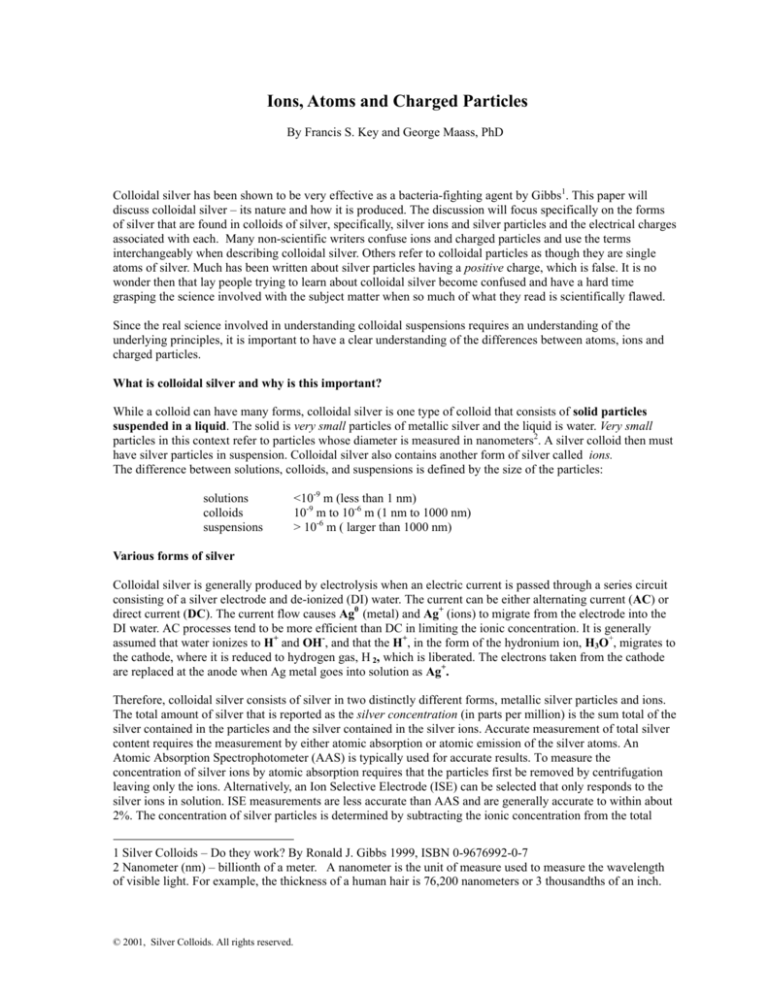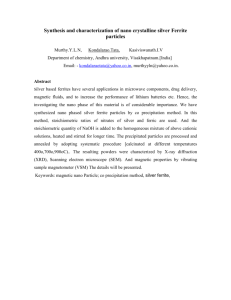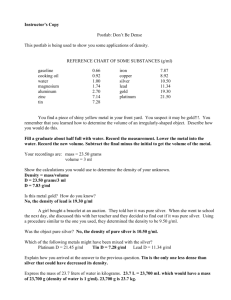
Ions, Atoms and Charged Particles
By Francis S. Key and George Maass, PhD
Colloidal silver has been shown to be very effective as a bacteria-fighting agent by Gibbs1. This paper will
discuss colloidal silver – its nature and how it is produced. The discussion will focus specifically on the forms
of silver that are found in colloids of silver, specifically, silver ions and silver particles and the electrical charges
associated with each. Many non-scientific writers confuse ions and charged particles and use the terms
interchangeably when describing colloidal silver. Others refer to colloidal particles as though they are single
atoms of silver. Much has been written about silver particles having a positive charge, which is false. It is no
wonder then that lay people trying to learn about colloidal silver become confused and have a hard time
grasping the science involved with the subject matter when so much of what they read is scientifically flawed.
Since the real science involved in understanding colloidal suspensions requires an understanding of the
underlying principles, it is important to have a clear understanding of the differences between atoms, ions and
charged particles.
What is colloidal silver and why is this important?
While a colloid can have many forms, colloidal silver is one type of colloid that consists of solid particles
suspended in a liquid. The solid is very small particles of metallic silver and the liquid is water. Very small
particles in this context refer to particles whose diameter is measured in nanometers2. A silver colloid then must
have silver particles in suspension. Colloidal silver also contains another form of silver called ions.
The difference between solutions, colloids, and suspensions is defined by the size of the particles:
solutions
colloids
suspensions
<10-9 m (less than 1 nm)
10-9 m to 10-6 m (1 nm to 1000 nm)
> 10-6 m ( larger than 1000 nm)
Various forms of silver
Colloidal silver is generally produced by electrolysis when an electric current is passed through a series circuit
consisting of a silver electrode and de-ionized (DI) water. The current can be either alternating current (AC) or
direct current (DC). The current flow causes Ag0 (metal) and Ag+ (ions) to migrate from the electrode into the
DI water. AC processes tend to be more efficient than DC in limiting the ionic concentration. It is generally
assumed that water ionizes to H+ and OH-, and that the H+, in the form of the hydronium ion, H3O+, migrates to
the cathode, where it is reduced to hydrogen gas, H 2, which is liberated. The electrons taken from the cathode
are replaced at the anode when Ag metal goes into solution as Ag+.
Therefore, colloidal silver consists of silver in two distinctly different forms, metallic silver particles and ions.
The total amount of silver that is reported as the silver concentration (in parts per million) is the sum total of the
silver contained in the particles and the silver contained in the silver ions. Accurate measurement of total silver
content requires the measurement by either atomic absorption or atomic emission of the silver atoms. An
Atomic Absorption Spectrophotometer (AAS) is typically used for accurate results. To measure the
concentration of silver ions by atomic absorption requires that the particles first be removed by centrifugation
leaving only the ions. Alternatively, an Ion Selective Electrode (ISE) can be selected that only responds to the
silver ions in solution. ISE measurements are less accurate than AAS and are generally accurate to within about
2%. The concentration of silver particles is determined by subtracting the ionic concentration from the total
1 Silver Colloids – Do they work? By Ronald J. Gibbs 1999, ISBN 0-9676992-0-7
2 Nanometer (nm) – billionth of a meter. A nanometer is the unit of measure used to measure the wavelength
of visible light. For example, the thickness of a human hair is 76,200 nanometers or 3 thousandths of an inch.
© 2001, Silver Colloids. All rights reserved.
silver concentration.
Typically, silver ions make up 75 to 99 percent of the total silver while only 1 to 25 percent of the total silver is
particles. A solution containing only ionic silver and no particles is not a colloid since there are no solid silver
particles in suspension. On the other hand, if 100 percent of the silver was particles and no ions were present,
the solution would be a pure colloid. One measure of the quality of a silver colloid is the percentage of silver
particles. Ideally, all the silver content would be in the form of particles with no silver ions.
The authors believe that a truer representation of the contents of a colloidal silver product would be to report on
the label the silver concentration of only the silver particles. An alternative would be to report what percentage
of total silver is contained in the particles and what percent is ionic.
Silver atoms
A single silver atom can be considered to be an atomic sized particle of metallic silver. It is the smallest size of
silver matter that exists. The diameter of a single silver atom is 0.288 nm. While it is theoretically possible to
have a particle of metallic silver that consists of a single atom, in practice particles are much larger and consist
of many atoms. Just for reference, a particle one nanometer in diameter would consist of 31 silver atoms, and a
5 nm diameter particle would be about 3900 atoms while a 20 nm diameter particle would contain about
250,000 silver atoms. The particle size typically observed in colloidal silver has been measured in the range of 5
to 200 nanometers. Such measurements are performed using a Photon Correlation Spectrometer (PCS) that can
measure down to 1 nm. In our laboratory a Malvern Zetasizer 3000HS is used to make such measurements.
Silver ions
A silver ion is a single atom of silver that is missing one electron from its outer orbit. The diameter of a silver
ion is 0.230 nm, which is slightly smaller than an atom owing to one less electron. Ag has the electron
configuration [Kr]4d105s1. When Ag – e ? Ag+, it is the 5s1 electron which is lost. The missing electron causes
the ion to be positively charged and also changes the physical properties in some very dramatic ways. Metallic
silver is not soluble in water, but ionic silver has a finite measurable solubility. Typically, silver is dissolved in
an acid such as nitric acid to form silver nitrate. When silver is dissolved, it is no longer metallic silver. It is not
visible even under the most powerful microscope and it does not reflect light. Even a solution saturated with
Ag+ ions has no Tyndall effect 3, but a colloidal Ag does, even in concentrations as little as 0.1 ppm. The
solubility product constant, Ksp for AgOH is 1.52 x 10-8, which means that, in a neutral solution, one could have
9.2 x 1022 Ag ions per liter without getting precipitation.
In summary, a silver ion is positively charged because it lacks an electron. An electron has a negative charge.
Take away an electron and the ion so formed assumes a positive charge. The charge attributed to ions is ionic
charge and it is due to the gain or loss of electrons. This is not the same as a particle that may have a charge.
Particle charge is due the adsorption of charged species. In fact the silver particles found in colloidal silver are
negatively charged, not positive like the ions.
Charged particles
Silver particles that are suspended in pure water to form a colloid will assume a negative charge that is called
the zeta potential. Most solids develop a negative zeta potential when dispersed in water of low ionic
concentration. The charge acquired by the particles is partly due to the adsorption of ions in the solution. The
surface charge gives rise to a potential distribution around the particle: the value of this potential at the slipping
plane 4 is defined as the zeta potential.
3 Tyndall effect – The scattering of light as it passes through a medium containing small particles.
4 Slipping plane – An electrical double layer exists around each particle. The liquid layer surrounding the
particle exists as two parts; an inner region (Stern layer) where the ions are strongly bound and an outer
(diffuse) region where they are less firmly associated. Within the diffuse layer is a notional boundary known as
the slipping plane, within which the particle acts as a single entity.
© 2001, Silver Colloids. All rights reserved.
2
The zeta potential of colloidal silver solutions that contain silver ions will typically be in the range of –35 to –45
millivolts (mV) depending on ionic content. The zeta potential of silver colloids that contain no silver ions will
have a higher negative potential of about –50 mV. The higher the ionic content, the less negative the zeta
potential since the positive charge of the silver ions will cancel some of the negative charge on the particles.
Particles have a negative charge
In the case of colloidal silver, the silver ions present are positively charged, so how do the silver particles
acquire a negative charge? Silver ions are created during the electrolysis that makes colloidal silver. The
creation of silver ions would tend to make the net charge of the solution positive. However, solutions always
have a net charge very close to zero because Coulomb force is extremely strong, and even a tiny charge
imbalance creates enough voltage to ionize everything in-between and cancel it. Ionization breaks the water
molecule into hydrogen H+ and hydroxyl ions OH-, which are negatively charged. The negative charge of the
hydroxyl ions counters the positive charge of the silver ions and maintains a solution of whose net charge is
zero. Thus the negative hydroxyl ions are created at the same time that the positive silver ions and silver
particles are created. The hydroxyl ions are non-metallic ions that bond to the atoms of the silver particles thus
imparting their negative charge to the particles.
Oxygen has 6 valence electrons and 2 hydrogens have one each, for a total of 8.
Therefore the Lewis structure 5 of H2O is
This is known as AX4E2 structure
(4 electron clouds, 2 unshared pairs)
Which would be bent, with a bond angle of 107o
The actual bond angle is 105o , due to the repulsion of the 2 unshared pairs.
When H ionizes as H+, that leaves the non-metallic OH- anion 6, which would have the following structure and
would be polar
Negative end
Positive end
As in the case of sols, when the OH- anion approaches the Ag atom, although that atom is neutral, the first thing
it sees is the 5s1 electron, therefore, the H, or positive, end of the anion is attracted to the atom, leaving the
negative end sticking out into the solution. This behavior is well documented for sols (colloidal particles which
have charged particles adsorbed on them). The mutual repulsion of the similar charges then stabilizes the colloid
by keeping the particles from agglomerating.
5 G. N. Lewis – Valence and Structure of Atom and Molecules, Dover Publications, Inc. NY 1966
6 Anion – A negatively charged ion, i.e. an ion that is attracted to the anode in electrolysis.
© 2001, Silver Colloids. All rights reserved.
3
Why are the positive silver ions not attracted to the negative hydroxyl ions? The force of attraction or repulsion
of electric charges is inversely proportional to the dielectric constant of the medium surrounding the charges.
Water has a very high dielectric constant of about 80 at room temperature. This means that the two opposite
electric charges in water attract each other with a force only 1/80 as strong as in air or a vacuum. Thermal
agitation of the ions is great enough to cause the ions to dissociate. It is common that ions of opposite charge
coexist in solution. For example, when salt is dissolved in water the resulting solution contains sodium ions
(Na+) and chloride ions (Cl-) of opposite charge.
Measuring particle charge (zeta potential)
The charge imparted to particles dispersed in water is called zeta potential. Instruments designed to measure the
value of zeta potential do so by subjecting the sample to an electric field and then observing the movement of
particles toward an electrode of an electrophoresis cell. The sign of the charge of the particles in the electric
field determines direction of movement. A negative charge on the particle causes it to move toward a positive
electrode. A positive charge on the particle would cause it to move toward the negative electrode. The velocity
of the particle movement is determined by the amount of charge.
The velocity of movement of the particles is measured by evaluating the Doppler shift of scattered laser light.
The velocity of particle movement is directly related to its charge. The zeta potential is calculated from the
velocity. Zeta potential is expressed in millivolts and usually falls in the range of –70 mV to +70 mV. When the
value of the zeta potential is more negative than -30 mV the colloid is considered stable because the particles
have sufficient mutual repulsion to provide suspension stability. Zeta potential more positive than -15 mV
indicates a suspension at the threshold of agglomeration. Coagulation or flocculation is most rapid when the
zeta potential is 0 mV +/- 3 mV.
Zeta potential plot of colloidal silver.
© 2001, Silver Colloids. All rights reserved.
4
Download this document in Adobe pdf format from www.Silver-Colloids.com
Conclusion
Silver colloids must contain suspended particles of silver and usually also contain dissolved silver ions.
Solutions that contain only dissolved silver ions are not colloids. High quality colloids contain a high
percentage of silver particles. Ideally, a silver colloid would contain no ions.
Silver ions are positively charged and silver particles in colloidal suspension are negatively charged. Reducing
ionic silver content causes the zeta potential to become more negative increasing the stability of the colloid.
Colloidal silver products manufacturers would more accurately inform the user by listing on the label what
concentration of silver (in parts per million) is contained in the particles. An alternative would be to report what
percentage of total silver concentration is contained in the particles and what percent is ionic
About the authors
Francis S. Key is the principle scientist and founder of the Colloidal Science Laboratory which conducts
research on metal colloids. Mr. Key was educated at Columbia University and Newark College of Engineering.
He has an extensive background in the fields of electrical engineering, computer science, and various branches
of physics and engineering. Mr. Key’s experience in scientific research and engineering spans a period over 35
years, beginning with his contributions to the design of space flight hardware used on the Apollo and Viking
space missions. Mr. Key is known for meticulous attention to details, and relentless investigative procedures,
both of which have led to innovative solutions to problems in defense, aerospace and private industry.
Mr. Key has carefully researched the production of colloidal silver, and has built a laboratory facility for
colloidal research which is state of the art for the field. He has also instituted analytical methods and developed
manufacturing processes which insure the highest purity and consistency possible for a colloidal product. To
contact Mr. Key e-mail to: frank@silver-colloids.com
Dr. George Maass - Dr. George Maass holds degrees in chemistry from Fordham University and Iowa State
University. For the last 6 years, Dr. Maass has been a professor of chemistry at Camden County College, while
operating his own consulting business. He has authored papers and presented seminars on his work in the US,
England and Mexico.
Previously to that, Dr. Maass had a successful 25 year career in industry, during which time he applied
principles of physics, chemistry, and mathematics to solve diverse industrial problems, invented test methods
and developed equations to study structure and fluid behavior in porous materials, and invented and used
mathematical models for use in predictive technology, as well as being a consultant in the design of
experiments.
A recognized problem solver, he has a strong reputation for the ability to determine the fact which cause
phenomena to happen, and to describe the methods by which they can be controlled.
© 2001, Silver Colloids. All rights reserved.
5
Appendix A
Summary of Properties
for
Silver
Particles1 Atoms
Property
Increases conductivity of a solution it is added to
Tyndall Effect
Can be separated from solution by centrifugation
Properties will change if an electron is added
Properties will change if an electron is removed
Combines readily with anions
Combines readily with cations
Water soluble
Exists as a single entity in solution with it its peers
Measurable with an Ion Selective Electrode
Measurable by Atomic Absorption Spectrophotometer
Measurable by a Spectrophotometer
Possesses ionic charge
May posses particle charge
Combines with polar molecules
Negative zeta potential in low ionic solutions
Measurable with Photon Correlation Spectrometer
Can be separated from solution by filtration
Precipitates from solution onto cathode when an electric current is
passed passed through the solution
Notes:
N
N
N
N
Y
N
N
N
N
N
Y
N
N
N
N
N
N
N
Y
N
N
Y
N
Y
N
Y
Y
Y
Y
Y
Y
N
Y
N
N
N
N
N
Y
1 Particles – in this context, a particle is defined as a cluster of atoms.
© 2001, Silver Colloids. All rights reserved.
6
Ions
N
Y
Y
N
N
N
N
N
Y
N
Y
N
N
Y
Y
Y
Y
Y








